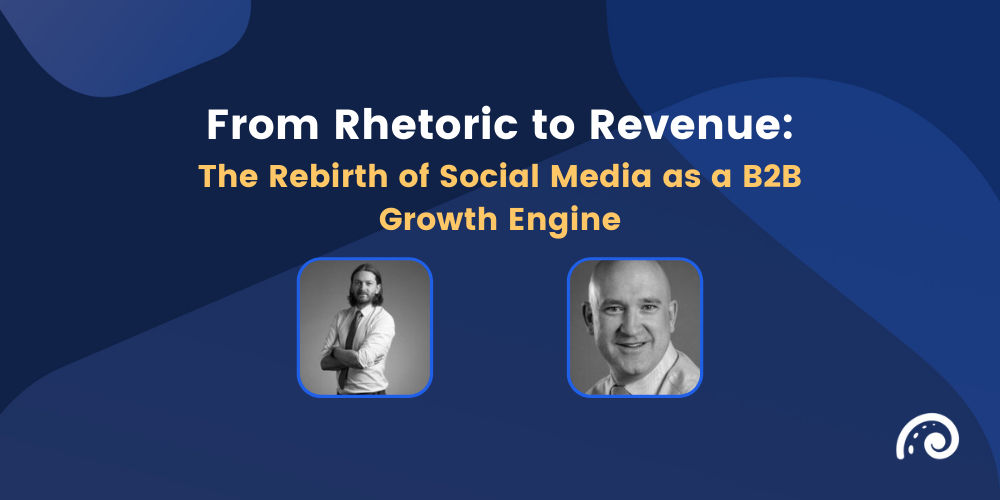How to increase customer loyalty through social media

Table of contents
When you have customers, you want to keep them. Period. It’s 50% easier to sell to existing customers than it is to land new ones. And, your social media marketing efforts are often what keep those existing customers engaged.
But is your B2B marketing strategy fully attuned to turning current customers into repeat buyers and advocates? It’s entirely possible not only to gain new leads from social, but to create a system where current customers are engaging with you consistently, reinforcing their own trust in your brand. Beyond just staying on your customer’s radar, make your products and services a part of their daily lives, and you’ll create customer relationships that spread good will for your company. The returns on such an arrangement are a no-brainer.
How can the B2B marketer start to increase customer loyalty through social media engagements? Here’s a few steps you can take.
Pay attention to customer sentiment
The best way to get started with customer loyalty is by empathizing with your buyersת wherever they happen to be in their professional lives. Enter the role of social listening.
By using specialized social media management tools, you can monitor social posts, discussion groups, and comments about your industry, and about your brand specifically. If you find discussions happening about issues your customers are concerned about, it’s the perfect chance to offer helpful suggestions that are tangential to your products and services. If your brand name is coming up in conversations, you can step in with helpful content or directly answer lingering questions.
Not all B2B marketers track sentiment, so if you’re an early adopter, you’ll have the advantage in tracking a phenomenon that will only become more and more important in B2B marketing. Social listening is one of the ultimate keys to determining how your customers really feel about you, which is the first step in solidifying positive impressions and creating future loyalty. Here’s how to implement a listening protocol that unearths customer sentiment:
- Use software to centralize social media accounts. Having a global overview of all your social outlets at your fingertips will make it easy for you to “listen in” on what your customers are saying across channels.
- Make a list of keywords to track. Before you look in on your customers’ revealing conversations, you have to have an idea of what words they’re using. Accordingly, you should compose a list of keywords, sourced from previous high-performing content and the insights of your marketing and sales staff. Such a list should, at a minimum, contain your brand name, product name, and the top 10-20 words or phrases people use in your niche when considering a purchase. Your social media management software can help you note occurrences of these words across social networks.
- Listen out for subjective speech. In the searches you’ve conducted in the last step, here’s where you look at the emotional context. Take note—do you detect frustration, happiness, apprehension? Take note of those things, and add content to your social editorial calendar that enhances the positive, hopeful sentiments about your industry while defusing the negative feelings.
- Meet with sales for further insights. Those who have had real-world contact with customers are sources of insight you might not be able to get anywhere else. They can often identify common impressions they’ve gotten from dealing with customers.
After implementing these steps, you’ll have a good understanding of customer sentiment in your market. If your brand already has significant market share, you’ll also have a sense of the thoughts people have towards your company, and you’ll see what positive thoughts can be reinforced and what negative ideas can be rooted out through shrewd content publication. And all of the above will set the stage for enhanced loyalty down the line.
Combine insights from your CRM and social
You already have customers. And you already know how the relationships with them have evolved and what sentiment you’ve detected. This is invaluable data.
When you take what you’ve learned from social listening and combine it with insights into how your real-time customers feel, you’ll have all the intelligence you need for crafting a consistently attractive experience that inspires loyalty.
Here are some ways of mining your customer relationships for invaluable data:
- The obvious: ask your customers how they feel about you! All it takes is a simple survey, consisting of a few questions. Let customers tell you, both through multiple choice answers and in their own words, what they like about your brand message, your products, and what concerns or unresolved issues they have with both.
- Analyze what your CRM software says about your customers. Collect data across touch points about customer sentiment. Brainstorm with colleagues in sales about their impressions of important customer relationships.
- Compare your ideal customer profiles with current relationships. Determine whether the journeys that some of your best customers have with your brand measure up to the model put forth by your ideal customer profile. From there, you can ask a few important questions: are customers happy with your services, or might there be some dissatisfaction lurking under the surface? Do you need to work harder to generate demand, or perhaps present offers in a different way to truly appeal to the market segment in question? Based on what you gather from current customers, see if your customer profiles still hold up as they are.
Now, you’re primed to create and reinforce ongoing customer loyalty by assembling new content from all the insights you’ve gained. Be sure to aggregate all of the knowledge of customer sentiment and satisfaction levels you’ve collected from your CRM solution, and include refined customer profiles, surveys, and case studies. Schedule social and blog content that addresses customer concerns and questions, delights and fears, using your social media marketing software.
Before you know it, you’ll have a blueprint for what makes customers happy—and what does so on a regular basis.
Recommended for further reading
Let customer advocacy grow out of interactivity
Of course, building customer loyalty goes beyond just serving up excellent content all the time. The ultimate in customer loyalty is involving your buyers in unfolding story that is your brand. That is, B2B marketers should turn their company’s most loyal customers into advocates.
In one study, 87% of large companies (500+ employees) and 70% of smaller companies consult online product reviews. Thus, it’s more important than ever to inspire positive reviews from consistent buyers. Turning customers into brand advocates represents a win-win situation: they will become more loyal, and through their testimonials, similar customers will also become loyal buyers.
Start by approaching current customers for case studies. Particularly if they’re repeat buyers, some of them will likely have formed rich impressions of the relationship you have with them, and they’ll be able to put a positive spin on your brand that piques the interest of industry peers. Even better, try to get video testimonials from happy customers, and distribute them through social channels. A study by Simply Measured found that video content is shared on Facebook 1200% more than text and link posts combined—so the power of video for spreading brand awareness and good sentiment is not to be ignored.
Finally, interact with your best customers. Share and comment on their best social posts. Generally involve yourself in their social media activity in a non-obtrusive way. In the modern age of marketing, cementing customer loyalty often involves staying top-of mind in consistent, mutually beneficial social interactions.
The path to creating B2B customer loyalty is more straightforward than ever
Social media is, after all, about being social. And B2B brands can take advantage of this to create real bonds with customers that stand the test of time. By focusing on improving customer loyalty with the above advice, your brand will experience more growth and more positive press, no matter what industry you’re in.




